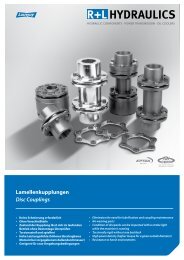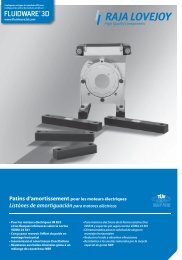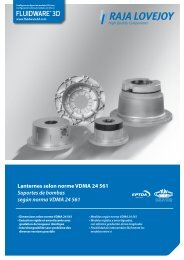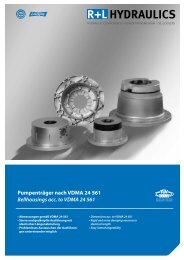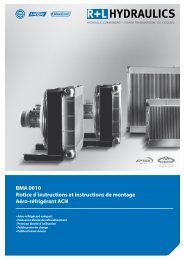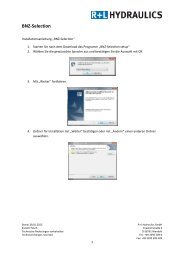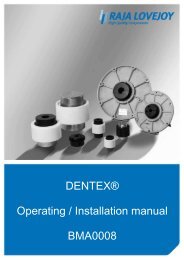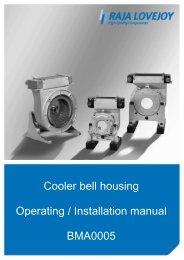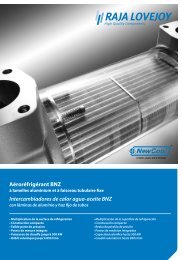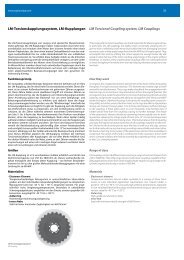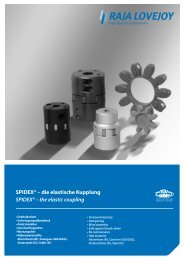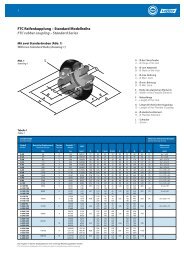Sie wollen auch ein ePaper? Erhöhen Sie die Reichweite Ihrer Titel.
YUMPU macht aus Druck-PDFs automatisch weboptimierte ePaper, die Google liebt.
l-hydraulics.com<br />
Auswahl der Torsionskupplung<br />
für Verbrennungsmotoranwendungen<br />
Bei korrekter Auswahl und Bemessung dämpft die Lovejoy Torsionskupplung<br />
wirkungsvoll Vibrationen und gewährleistet, dass die Anlage, die von<br />
Diesel, Benzin oder Erdgas-Kolbenmotoren angetrieben wird, nicht innerhalb<br />
der kritischen Frequenz betrieben wird. Um jedoch sicherzustellen,<br />
dass die Kupplung ihre Aufgabe wie vorgesehen erfüllt, sollte die Auswahl<br />
mittels einer Drehschwingungsanalyse verifiziert werden.<br />
Die falsche Auswahl einer Kupplung in einer Motoranwendung führt häufig<br />
zu einem Kupplungsausfall oder einem Anlagenschaden. Wir empfehlen<br />
Ihnen die optimale Kupplung von R+L HYDRAULICS auswählen zu<br />
lassen.<br />
Wir stellen sicher, dass die korrekte Kupplungsgröße und -steifheit nicht<br />
nur für das richtige nominale und maximale Drehmoment ausgewählt wird,<br />
sondern auch für den schwer fassbaren Faktor eines ständig einwirkenden<br />
Vibrationsmoments, das sonst eine Elastomer-Kupplung schmelzen oder<br />
zerreißen und andere Systemkomponenten beschädigen könnte.<br />
FüllenSiebittedasInformations-ArbeitsblattaufSeite10ausundsenden<br />
Sie dieses per Fax an R+L HYDRAULICS zur Auswahl der Kupplung. Oder<br />
senden Sie uns diese Information per Email, indem Sie das Arbeitsblatt<br />
ausfüllen, das Sie auf unserer Website www.rl-hydraulics.com finden. Für<br />
die, die in ihren technischen Fähigkeiten sicher sind und die Torsionsanalyse<br />
eines Systems verstehen und deshalb ihre eigene Kupplungsauswahl treffen<br />
wollen, stellen wir folgende essenzielle Richtlinien bereit.<br />
1. Wählen Sie ein Modell aus, das zu Ihrem Antriebssystem passt,<br />
indem Sie die vorab gegebenen Beschreibungen der Basismodelle<br />
auf den Seiten 4 und 5 berücksichtigen.<br />
• Modell 3 oder 3/S – Für die direkte Montage auf SAE-Standardschwungscheiben.<br />
• Modell 2 oder 2/S – Für Welle-Welle-Anwendungen wie bei typischen<br />
Kraftübertragungen. Auch kann die Flanschnabe zur Anpassung an Dämpfungsscheiben<br />
modifiziert werden.<br />
• Modell 1 oder 1/S – Für die Verbindung einer Welle mit einem Flansch<br />
oder einer Nicht-Standardschwungscheibe.<br />
• Modell 6 – Es stehen verschiedene universelle Baugruppen mit fliegenden<br />
Wellen zur Verfügung (siehe Seite 20).<br />
2. Nenndrehmoment<br />
Das von der Kupplung übertragene Nenndrehmoment (T LN ) darf nicht<br />
mehr als das Nenndrehmoment der Kupplung (T KN ) bei irgendeiner gegebenen<br />
Betriebstemperatur sein:<br />
T KN ≥ T LN × S t<br />
wobei S t der Temperaturfaktor (Abb.1, Seite 14) und<br />
T LN (Nm) = (kW × 9555)/U/min ist.<br />
3. Drehmoment-Impulsspitzen<br />
Die Magnitude der maximalen Drehmomentimpulse (T max ), die über den gesamten<br />
Betriebstemperaturbereich hinweg während des Betriebs auftreten,<br />
dürfen die maximale Drehmomentauslegung (T Kmax ) der Kupplung nicht<br />
überschreiten. Dies sind kurzzeitige transiente Impulse, die vom Starten,<br />
von Stößen oder von der Beschleunigung zur Erreichung der Betriebsdrehzahl<br />
durch eine Systemresonanz verursacht werden können. Per<br />
Definition können diese Impulse während der Lebensdauer der Kupplung<br />
10 5 mal in eine der Drehrichtungen oder 5 × 10 4 mal in die andere Richtung<br />
auftreten.<br />
T Kmax ≥ T max × S t<br />
Torsional Coupling selection<br />
for internal combustion engine applications<br />
When correctly sized and selected, the Lovejoy Torsional Coupling will effectively<br />
dampen vibration and tune critical frequencies out of the operating range of<br />
systems driven by diesel, gasoline or natural gas reciprocating engines. But to<br />
make sure the coupling will do its job as intended, the selection should be verified<br />
with a torsional vibration analysis of the system.<br />
Misapplication of the coupling in an engine application frequently leads<br />
to coupling failure or system damage. For these applications, we strongly<br />
urge that you let R+L HYDRAULICS make the coupling selection for you.<br />
We will insure that the correct coupling size and stiffness is selected not only for<br />
proper nominal and maximum torque, but also for the elusive factor of continuous<br />
vibratory torque which can otherwise melt or rupture an elastomeric<br />
coupling or damage other system components.<br />
Please complete the information worksheet on page 10 and fax it to<br />
R+L HYDRAULICS for selection. Or you may e-mail us by filling out the version<br />
of this worksheet found on our web site at www.rl-hydraulics.com.<br />
For those confident in their technical abilities and understanding of system torsional<br />
analysis who prefer to make their own coupling selection, we provide the<br />
following essential guidelines.<br />
1. Choose a model that suits your drive arrangement using the descriptions of<br />
basic models given previously on pages 4 and 5.<br />
• Model 3 or 3/S – For mounting directly to standard SAE flywheels.<br />
• Model 2 or 2/S – For shaft-to-shaft applications such as PTOs. Also, the<br />
flanged hub can be modified to adapt to front damper pulleys.<br />
• Model 1 or 1/S – For connecting a shaft to a flange or non-standard flywheel.<br />
• Model 6 – Various different universal floating shaft arrangements available<br />
(see page 20)<br />
2. Nominal torque<br />
The nominal torque transmitted though the coupling (T LN ) must be no more<br />
than the nominal torque rating for the coupling (T KN ) at any given operating<br />
temperature:<br />
T KN ≥ T LN × S t<br />
where S t is the temperature factor (Fig.1, p.14), and<br />
T LN (Nm) = (kW × 9555)/RPM<br />
3. Peak torque pulses<br />
The magnitude of the maximum torque pulses that occur during operation<br />
(T max ) at all operating temperatures must not exceed the maximum torque<br />
rating of the coupling (T Kmax ). These are short-duration transient pulses that<br />
would result from start-up, shock, or acceleration through a system resonance<br />
to reach operating speed. By definition, these pulses may occur over<br />
the life of the coupling 10 5 times in one direction of rotation, or 5 × 10 4 times<br />
reversing.<br />
T Kmax ≥ T max × S t<br />
8




